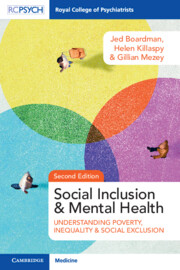Book contents
- Social Inclusion and Mental Health
- Reviews
- Social Inclusion and Mental Health
- Copyright page
- Contents
- Foreword to Second Edition
- Foreword to First Edition (2010)
- Preface
- Acknowledgements
- Chapter 1 Introduction: Poor, Excluded, and Unequal
- Section 1 Social Exclusion, Poverty, and Inequality
- Section 2 Participation of People with Mental Health Conditions
- Chapter 9 Mental Health Inequalities and Exclusion
- Chapter 10 Exclusion from Material Resources
- Chapter 11 Exclusion from Socially Valued Activities
- Chapter 12 Exclusion from Social Relations and Neighbourhoods
- Chapter 13 Exclusion from Health and Health Services
- Chapter 14 Exclusion from Civic Participation
- Chapter 15 Social Exclusion in Specific Social Groups and Individuals with Mental Health Conditions
- Chapter 16 Social Exclusion and People with Mental Health Conditions: Developing a Clearer Picture
- Section 3 Including People
- Index
- References
Chapter 11 - Exclusion from Socially Valued Activities
from Section 2 - Participation of People with Mental Health Conditions
Published online by Cambridge University Press: 24 November 2022
- Social Inclusion and Mental Health
- Reviews
- Social Inclusion and Mental Health
- Copyright page
- Contents
- Foreword to Second Edition
- Foreword to First Edition (2010)
- Preface
- Acknowledgements
- Chapter 1 Introduction: Poor, Excluded, and Unequal
- Section 1 Social Exclusion, Poverty, and Inequality
- Section 2 Participation of People with Mental Health Conditions
- Chapter 9 Mental Health Inequalities and Exclusion
- Chapter 10 Exclusion from Material Resources
- Chapter 11 Exclusion from Socially Valued Activities
- Chapter 12 Exclusion from Social Relations and Neighbourhoods
- Chapter 13 Exclusion from Health and Health Services
- Chapter 14 Exclusion from Civic Participation
- Chapter 15 Social Exclusion in Specific Social Groups and Individuals with Mental Health Conditions
- Chapter 16 Social Exclusion and People with Mental Health Conditions: Developing a Clearer Picture
- Section 3 Including People
- Index
- References
Summary
This chapter covers three main areas of activity: the labour market, education, and leisure. These three areas all overlap and interact within the scope of the human life course and have important implications for health and socio-economic outcomes. They are also interdependent with the material factors and the social networks examined in other chapters. All are inequitably distributed and are important for the health and well-being of the general population. People with mental health conditions are disadvantaged in all three of these areas, especially those with severe and enduring conditions, and work, leisure, and education can all play a role in causing and perpetuating mental ill-health. Factors that are integral to the mental health condition may contribute to excluding people from these important activities, but there are additional extrinsic factors that also play a part in this exclusion. The existence of such external factors supports the application of a social model of disability for people with mental health conditions and questions the assumptions of an approach that views exclusion solely in terms of a person’s ‘illness’. This has implications for the rehabilitation and the personal and social recovery of people with enduring mental health conditions.
Keywords
- Type
- Chapter
- Information
- Social Inclusion and Mental HealthUnderstanding Poverty, Inequality and Social Exclusion, pp. 227 - 248Publisher: Cambridge University PressPrint publication year: 2022

